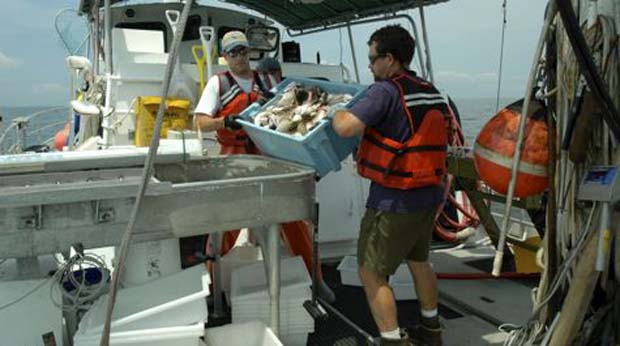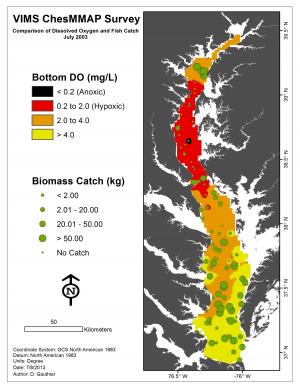By David Malmquist, VIMS | July 8, 2013
[dropcap]A[/dropcap]10-year study of Chesapeake Bay fishes by researchers at William & Mary’s Virginia Institute of Marine Science provides the first quantitative evidence on a bay-wide scale that low-oxygen “dead zones” are impacting the distribution and abundance of “demersal” fishes—those that live and feed near the Bay bottom.
Andre Buchheister and Jason Romine prepare to sort the trawl-net catch during a ChesMMAP cruise on Chesapeake Bay.
Photo courtesy of ChesMMAP program
The affected species—which include Atlantic croaker, white perch, spot, striped bass, and summer flounder—are a key part of the Chesapeake Bay ecosystem and support important commercial and recreational fisheries.
The study, published in a recent issue of Marine Ecology Progress Series, was authored by Andre Buchheister, a Ph.D. student in William & Mary’s School of Marine Science at VIMS, along with VIMS colleagues Chris Bonzek, Jim Gartland, and Dr. Rob Latour.

Data from VIMS’ ChesMMAP survey illustrate the large dead zone that developed in Chesapeake Bay in the late summer of 2003. Dead zone in red in relation to fish catches (green circles). Credit: Debra Gauthier/VIMS.
All four authors are involved in VIMS’ Chesapeake Bay Multi-Species Monitoring and Assessment Program (ChesMMAP), an ongoing effort to track and understand interactions between and among fishes and other marine life within the Bay ecosystem.
Buchheister says “This is the first study to document that chronically low levels of dissolved oxygen in Chesapeake Bay can reduce the number and catch rates of demersal fish species on a large scale.” He notes that other studies have looked at the effects of low oxygen on fishes within the water column and on demersal fishes within individual Bay tributaries.
Low-oxygen conditions—what scientists call “hypoxia”—form when excessive loads of nitrogen from fertilizers, sewage, and other sources feed algal blooms in coastal waters. When these algae die and sink, they provide a rich food source for bacteria, which in the act of decomposition take up dissolved oxygen from nearby waters.
In Chesapeake Bay, low-oxygen conditions are most pronounced in mid-summer, and in the deep waters of the Bay’s middle reaches. “This appears to displace fish biomass toward the northern and southern edges of the bay’s mainstem channel,” says Buchheister.
“The drastic decline we saw in species richness, species diversity, and catch rate under low-oxygen conditions is consistent with work from other systems,” he adds. “It suggests that demersal fishes begin to avoid an area when levels of dissolved oxygen drop below about 4 milligrams per liter, as they start to suffer physiological stress.”
To read complete story click here […]


